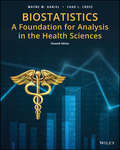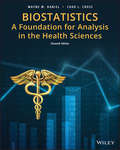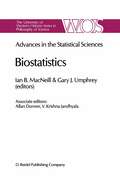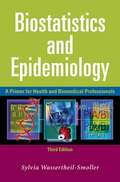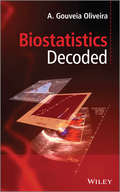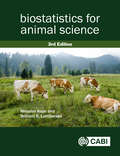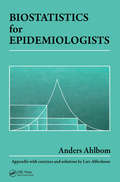- Table View
- List View
Biostatistics: A Foundation for Analysis in the Health Sciences (Wiley Series In Probability And Statistics: Probability And Statistics Section Ser. #Vol. 468)
by Wayne W. Daniel Chad L. CrossThe ability to analyze and interpret enormous amounts of data has become a prerequisite for success in allied healthcare and the health sciences. Now in its 11th edition, Biostatistics: A Foundation for Analysis in the Health Sciences continues to offer in-depth guidance toward biostatistical concepts, techniques, and practical applications in the modern healthcare setting. Comprehensive in scope yet detailed in coverage, this text helps students understand—and appropriately use—probability distributions, sampling distributions, estimation, hypothesis testing, variance analysis, regression, correlation analysis, and other statistical tools fundamental to the science and practice of medicine. Clearly-defined pedagogical tools help students stay up-to-date on new material, and an emphasis on statistical software allows faster, more accurate calculation while putting the focus on the underlying concepts rather than the math. Students develop highly relevant skills in inferential and differential statistical techniques, equipping them with the ability to organize, summarize, and interpret large bodies of data. Suitable for both graduate and advanced undergraduate coursework, this text retains the rigor required for use as a professional reference.
Biostatistics: A Foundation for Analysis in the Health Sciences
by Wayne W. Daniel Chad L. CrossThe ability to analyze and interpret enormous amounts of data has become a prerequisite for success in allied healthcare and the health sciences. Now in its 11th edition, Biostatistics: A Foundation for Analysis in the Health Sciences continues to offer in-depth guidance toward biostatistical concepts, techniques, and practical applications in the modern healthcare setting. Comprehensive in scope yet detailed in coverage, this text helps students understand—and appropriately use—probability distributions, sampling distributions, estimation, hypothesis testing, variance analysis, regression, correlation analysis, and other statistical tools fundamental to the science and practice of medicine. Clearly-defined pedagogical tools help students stay up-to-date on new material, and an emphasis on statistical software allows faster, more accurate calculation while putting the focus on the underlying concepts rather than the math. Students develop highly relevant skills in inferential and differential statistical techniques, equipping them with the ability to organize, summarize, and interpret large bodies of data. Suitable for both graduate and advanced undergraduate coursework, this text retains the rigor required for use as a professional reference.
Biostatistics: Advances in Statiscal Sciences Festschrift in Honor of Professor V.M. Joshi’s 70th Birthday Volume V (The Western Ontario Series in Philosophy of Science #38)
by I. B. MacNeill G. UmphreyOn May 27-31, 1985, a series of symposia was held at The University of Western Ontario, London, Canada, to celebrate the 70th birthday of Pro fessor V. M. Joshi. These symposia were chosen to reflect Professor Joshi's research interests as well as areas of expertise in statistical science among faculty in the Departments ofStatistical and Actuarial Sciences, Economics, Epidemiology and Biostatistics, and Philosophy. From these symposia, the six volumes which comprise the "Joshi Festschrift" have arisen. The 117 articles in this work reflect the broad interests and high quality of research of those who attended our conference. We would like to thank all of the contributors for their superb cooperation in helping us to complete this project. Our deepest gratitude must go to the three people who have spent so much of their time in the past year typing these volumes: Jackie Bell, Lise Constant, and Sandy Tarnowski. This work has been printed from "camera ready" copy produced by our Vax 785 computer and QMS Lasergraphix printers, using the text processing software TEX. At the initiation of this project, we were neophytes inthe use ofthis system. Thank you, Jackie, Lise, and Sandy, for having the persistence and dedication needed to complete this undertaking.
Biostatistics: A Methodology For the Health Sciences (Wiley Series in Probability and Statistics #519)
by Gerald van Belle Lloyd D. Fisher Patrick J. Heagerty Thomas LumleyA respected introduction to biostatistics, thoroughly updated and revised The first edition of Biostatistics: A Methodology for the Health Sciences has served professionals and students alike as a leading resource for learning how to apply statistical methods to the biomedical sciences. This substantially revised Second Edition brings the book into the twenty-first century for today’s aspiring and practicing medical scientist. This versatile reference provides a wide-ranging look at basic and advanced biostatistical concepts and methods in a format calibrated to individual interests and levels of proficiency. Written with an eye toward the use of computer applications, the book examines the design of medical studies, descriptive statistics, and introductory ideas of probability theory and statistical inference; explores more advanced statistical methods; and illustrates important current uses of biostatistics. New to this edition are discussions of Longitudinal data analysis Randomized clinical trials Bayesian statistics GEE The bootstrap method Enhanced by a companion Web site providing data sets, selected problems and solutions, and examples from such current topics as HIV/AIDS, this is a thoroughly current, comprehensive introduction to the field.
Biostatistics and Epidemiology: A Primer for Health and Biomedical Professionals
by Jordan Smoller Sylvia Wassertheil-SmollerThis book teaches foundations of epidemiological design and statistical methods, as well as including topics applicable to new areas of research. Since the publication of the first edition, Biostatistics and Epidemiology has attracted loyal readers from various specialty areas in the biomedical community. The Fifth Edition includes coverage of fixed and random effects and mixed effects models; Poisson regression; constructing confidence intervals for U-shaped relationships; analysis of rare variants; Mendelian randomization; and aspects of machine learning and big data analytics. Biostatistics and Epidemiology was written to be accessible for readers without backgrounds in mathematics. It provides clear explanations of underlying principles, as well as practical guidelines of "how to do it" and "how to interpret it." Key features include a philosophical and logical explanation at the beginning of the book, subsections that can stand alone or serve as reference, cross-referencing, recommended reading, and appendices covering sample calculations for various statistics in the text.
Biostatistics and Epidemiology: A Primer for Health Professionals
by Sylvia Wassertheil-SmollerBiostatistics and Epidemiology: A Primer for Health Professionals focuses on the underlying framework of the field and offers practical guidelines for research and interpretation. In addition to major sections devoted to statistics and epidemiology, the book includes a comprehensive exploration of the scientific method, probability, and clinical trials. New to the second edition are: -a reorganization of the material -new information on survival analysis such as the Cox proportional hazards model -topics in nonparametric statistics -expanded discussion of probability and its applications in epidemiology -an entirely new chapter on areas relevant to behavioral research and change scores, reliability, validity, and responsiveness -new appendices providing specific and clear instructions on how to carry out several additional statistical calculations and tests Biostatistics and Epidemiology describes principles and methods applicable to medicine, public health, allied health, psychology and education and will be useful not only to physicians doing clinical as well as basic science research, but also to students at undergraduate, graduate and medical school levels.
Biostatistics and Epidemiology: A Primer for Health Professionals
by Sylvia Wassertheil-SmollerBiostatistics and Epidemiology/A Primer for Health Professionals offers practical guidelines and gives a concise framework for research and interpretation in the field. In addition to major sections covering statistics and epidemiology, the book includes a comprehensive exploration of scientific methodology, probability, and the clinical trial. The principles and methods described in this book are basic and apply to all medical subspecialties, psychology and education. The primer will be especially useful to public health officials and students looking for an understandable treatment of the subject.
Biostatistics and Epidemiology: A Primer for Health and Biomedical Professionals
by Sylvia Wassertheil-SmollerFor the new edition of Biostatistics and Epidemiology, Dr. Wassertheil-Smoller has included several new chapters (genetic statistics, molecular epidemiology, scientific integrity and research ethics) and a new appendix on the basic concepts of genetics and a glossary of genetic terminology. She has also expanded the coverage of multi-center trials (an important aspect of implementation of the standards of evidence-based medicine), controversies in screening for prostate, colon, breast, and other cancers.
Biostatistics and Epidemiology: A Primer for Health and Biomedical Professionals
by Sylvia Wassertheil-Smoller Jordan SmollerSince the publication of the first edition, Biostatistics and Epidemiology has attracted loyal readers from across specialty areas in the biomedical community. Not only does this textbook teach foundations of epidemiological design and statistical methods, but it also includes topics applicable to new areas of research. Areas covered in the fourth edition include a new chapter on risk prediction, risk reclassification and evaluation of biomarkers, new material on propensity analyses, and a vastly expanded chapter on genetic epidemiology, which is particularly relevant to those who wish to understand the epidemiological and statistical aspects of scientific articles in this rapidly advancing field. Biostatistics and Epidemiology was written to be accessible for readers without backgrounds in mathematics. It provides clear explanations of underlying principles, as well as practical guidelines of "how to do it" and "how to interpret it." Key features include a philosophical and logical explanation at the beginning of the book, subsections that can stand alone or serve as reference, cross-referencing, recommended reading, and appendices covering sample calculations for various statistics in the text.
Biostatistics and Microbiology: A Survival Manual
by Daryl S. PaulsonThis "nuts and bolts" book provides a condensation of biostatistical methods that applied microbiology researchers need to perform data analyses. Based on the author’s more than two decades of applied research and teaching experience, it is presented in a straight-forward manner, applicable by practicing microbiologists with minimal backgrounds in mathematics. All methods rely only on the use of a basic hand-held calculator. The overriding goal of this book is to ground one’s microbiological expertise and experience in one’s research pursuits, using biostatistics not as a black box, but as a tool.
Biostatistics Decoded
by A. Gouveia OliveiraStudy design and statistical methodology are two important concerns for the clinical researcher. This book sets out to address both issues in a clear and concise manner. The presentation of statistical theory starts from basic concepts, such as the properties of means and variances, the properties of the Normal distribution and the Central Limit Theorem and leads to more advanced topics such as maximum likelihood estimation, inverse variance and stepwise regression as well as, time-to-event, and event-count methods. Furthermore, this book explores sampling methods, study design and statistical methods and is organized according to the areas of application of each of the statistical methods and the corresponding study designs. Illustrations, working examples, computer simulations and geometrical approaches, rather than mathematical expressions and formulae, are used throughout the book to explain every statistical method. Biostatisticians and researchers in the medical and pharmaceutical industry who need guidance on the design and analyis of medical research will find this book useful as well as graduate students of statistics and mathematics with an interest in biostatistics. Biostatistics Decoded: Provides clear explanations of key statistical concepts with a firm emphasis on practical aspects of design and analysis of medical research. Features worked examples to illustrate each statistical method using computer simulations and geometrical approaches, rather than mathematical expressions and formulae. Explores the main types of clinical research studies, such as, descriptive, analytical and experimental studies. Addresses advanced modeling techniques such as interaction analysis and encoding by reference and polynomial regression.
Biostatistics Decoded
by A. Gouveia OliveiraStudy design and statistical methodology are two important concerns for the clinical researcher. This book sets out to address both issues in a clear and concise manner. The presentation of statistical theory starts from basic concepts, such as the properties of means and variances, the properties of the Normal distribution and the Central Limit Theorem and leads to more advanced topics such as maximum likelihood estimation, inverse variance and stepwise regression as well as, time-to-event, and event-count methods. Furthermore, this book explores sampling methods, study design and statistical methods and is organized according to the areas of application of each of the statistical methods and the corresponding study designs. Illustrations, working examples, computer simulations and geometrical approaches, rather than mathematical expressions and formulae, are used throughout the book to explain every statistical method. Biostatisticians and researchers in the medical and pharmaceutical industry who need guidance on the design and analyis of medical research will find this book useful as well as graduate students of statistics and mathematics with an interest in biostatistics. Biostatistics Decoded: Provides clear explanations of key statistical concepts with a firm emphasis on practical aspects of design and analysis of medical research. Features worked examples to illustrate each statistical method using computer simulations and geometrical approaches, rather than mathematical expressions and formulae. Explores the main types of clinical research studies, such as, descriptive, analytical and experimental studies. Addresses advanced modeling techniques such as interaction analysis and encoding by reference and polynomial regression.
Biostatistics Decoded
by A. Gouveia OliveiraBiostatistics Decoded covered a large number of statistical methods that are mainly applied to clinical and epidemiological research, as well as a comprehensive discussion of study designs for observational research and clinical trials, two important concerns for the clinical researcher. In this second edition, new material is included covering statistical methods and study designs that are used to analyse research. Following the same methodology used in the first edition, the chapters are presented in two levels of detail, one for the reader who wishes only to understand the rationale behind each statistical method, and one for the reader who wishes to understand the computations Key features include: Extensive coverage of the design and analysis of experiments for basic science research Experimental designs are presented together with the statistical methods The rationale of all forms of ANOVA is explained with simple mathematics A comprehensive presentation of statistical tests for multiple comparisons Calculations for all statistical methods are illustrated with examples and explained step-by-step. This book presents biostatistical concepts and methods in a way that is accessible to anyone, regardless of his or her knowledge of mathematics. The topics selected for this book cover will meet the needs of clinical professionals to readers in basic science research.
Biostatistics Decoded
by A. Gouveia OliveiraBiostatistics Decoded covered a large number of statistical methods that are mainly applied to clinical and epidemiological research, as well as a comprehensive discussion of study designs for observational research and clinical trials, two important concerns for the clinical researcher. In this second edition, new material is included covering statistical methods and study designs that are used to analyse research. Following the same methodology used in the first edition, the chapters are presented in two levels of detail, one for the reader who wishes only to understand the rationale behind each statistical method, and one for the reader who wishes to understand the computations Key features include: Extensive coverage of the design and analysis of experiments for basic science research Experimental designs are presented together with the statistical methods The rationale of all forms of ANOVA is explained with simple mathematics A comprehensive presentation of statistical tests for multiple comparisons Calculations for all statistical methods are illustrated with examples and explained step-by-step. This book presents biostatistical concepts and methods in a way that is accessible to anyone, regardless of his or her knowledge of mathematics. The topics selected for this book cover will meet the needs of clinical professionals to readers in basic science research.
Biostatistics for Animal Science
by Miroslav Kaps William LambersonDesigned to cover techniques for analysis of data in the animal sciences, this popular textbook provides an overview of the basic principles of statistics enabling the subsequent applications to be carried out with familiarity and understanding. Each chapter begins by introducing a problem with practical questions, followed by a brief theoretical background. Most topics are followed up with numerical examples to illustrate the methods described using data-sets from animal sciences and related fields. The same examples are then solved using the SAS software package. Key features of this third edition: - Updated throughout, and covers a wealth of new distributions and new material on non-normal dependent variables - Improved clarity of text and examples - Includes both basic techniques and more complex procedures to provide an essential resource whatever your level - Contains exercises and many worked examples in SAS. Written primarily for students and researchers in animal sciences, the text is also useful for those studying agricultural, biological, and veterinary sciences.
Biostatistics for Clinical and Public Health Research
by Melody S. GoodmanBiostatistics for Clinical and Public Health Research provides a concise overview of statistical analysis methods. Use of SAS and Stata statistical software is illustrated in full, including how to interpret results. Focusing on statistical models without all the theory, the book is complete with exercises, case studies, take-away points, and data sets. Readers will be able to maximize their statistical abilities in hypothesis testing, data interpretation, and application while also learning when and how to consult a biostatistician. This book will be an invaluable tool for students and clinical and public health practitioners.
Biostatistics for Clinical and Public Health Research
by Melody S. GoodmanBiostatistics for Clinical and Public Health Research provides a concise overview of statistical analysis methods. Use of SAS and Stata statistical software is illustrated in full, including how to interpret results. Focusing on statistical models without all the theory, the book is complete with exercises, case studies, take-away points, and data sets. Readers will be able to maximize their statistical abilities in hypothesis testing, data interpretation, and application while also learning when and how to consult a biostatistician. This book will be an invaluable tool for students and clinical and public health practitioners.
Biostatistics For Dummies
by John PezzulloScore your highest in biostatistics Biostatistics is a required course for students of medicine, epidemiology, forestry, agriculture, bioinformatics, and public health. In years past this course has been mainly a graduate-level requirement; however its application is growing and course offerings at the undergraduate level are exploding. Biostatistics For Dummies is an excellent resource for those taking a course, as well as for those in need of a handy reference to this complex material. Biostatisticians—analysts of biological data—are charged with finding answers to some of the world's most pressing health questions: how safe or effective are drugs hitting the market today? What causes autism? What are the risk factors for cardiovascular disease? Are those risk factors different for men and women or different ethnic groups? Biostatistics For Dummies examines these and other questions associated with the study of biostatistics. Provides plain-English explanations of techniques and clinical examples to help Serves as an excellent course supplement for those struggling with the complexities of the biostatistics Tracks to a typical, introductory biostatistics course Biostatistics For Dummies is an excellent resource for anyone looking to succeed in this difficult course.
Biostatistics For Dummies
by John PezzulloScore your highest in biostatistics Biostatistics is a required course for students of medicine, epidemiology, forestry, agriculture, bioinformatics, and public health. In years past this course has been mainly a graduate-level requirement; however its application is growing and course offerings at the undergraduate level are exploding. Biostatistics For Dummies is an excellent resource for those taking a course, as well as for those in need of a handy reference to this complex material. Biostatisticians—analysts of biological data—are charged with finding answers to some of the world's most pressing health questions: how safe or effective are drugs hitting the market today? What causes autism? What are the risk factors for cardiovascular disease? Are those risk factors different for men and women or different ethnic groups? Biostatistics For Dummies examines these and other questions associated with the study of biostatistics. Provides plain-English explanations of techniques and clinical examples to help Serves as an excellent course supplement for those struggling with the complexities of the biostatistics Tracks to a typical, introductory biostatistics course Biostatistics For Dummies is an excellent resource for anyone looking to succeed in this difficult course.
Biostatistics For Dummies
by Monika Wahi John C. PezzulloBreak down biostatistics, make sense of complex concepts, and pass your class If you're taking biostatistics, you may need or want a little extra assistance as you make your way through. Biostatistics For Dummies follows a typical biostatistics course at the college level, helping you understand even the most difficult concepts, so you can get the grade you need. Start at the beginning by learning how to read and understand mathematical equations and conduct clinical research. Then, use your knowledge to analyze and graph your data. This new edition includes more example problems with step-by-step walkthroughs on how to use statistical software to analyze large datasets. Biostatistics For Dummies is your go-to guide for making sense of it all. Review basic statistics and decode mathematical equations Learn how to analyze and graph data from clinical research studies Look for relationships with correlation and regression Use software to properly analyze large datasets Anyone studying in clinical science, public health, pharmaceutical sciences, chemistry, and epidemiology-related fields will want this book to get through that biostatistics course.
Biostatistics For Dummies
by Monika Wahi John C. PezzulloBreak down biostatistics, make sense of complex concepts, and pass your class If you're taking biostatistics, you may need or want a little extra assistance as you make your way through. Biostatistics For Dummies follows a typical biostatistics course at the college level, helping you understand even the most difficult concepts, so you can get the grade you need. Start at the beginning by learning how to read and understand mathematical equations and conduct clinical research. Then, use your knowledge to analyze and graph your data. This new edition includes more example problems with step-by-step walkthroughs on how to use statistical software to analyze large datasets. Biostatistics For Dummies is your go-to guide for making sense of it all. Review basic statistics and decode mathematical equations Learn how to analyze and graph data from clinical research studies Look for relationships with correlation and regression Use software to properly analyze large datasets Anyone studying in clinical science, public health, pharmaceutical sciences, chemistry, and epidemiology-related fields will want this book to get through that biostatistics course.
Biostatistics for Epidemiologists
by Anders AhlbomBiostatistics for Epidemiologists is a unique book that provides a collection of methods that can be used to analyze data in most epidemiological studies. It examines the theoretical background of the methods described and discusses general principles that apply to the analysis of epidemiological data. Specific topics addressed include statistical interference in epidemiological research, important methods used for analyzing epidemiological data, multivariate models, dose-response analysis, analysis of the interaction between causes of disease, meta-analysis, and computer programs. Biostatistics for Epidemiologists will be a useful guide for all epidemiologists and public health professionals who rely on biostatistical data in their work.
Biostatistics for Epidemiologists
by Anders AhlbomBiostatistics for Epidemiologists is a unique book that provides a collection of methods that can be used to analyze data in most epidemiological studies. It examines the theoretical background of the methods described and discusses general principles that apply to the analysis of epidemiological data. Specific topics addressed include statistical interference in epidemiological research, important methods used for analyzing epidemiological data, multivariate models, dose-response analysis, analysis of the interaction between causes of disease, meta-analysis, and computer programs. Biostatistics for Epidemiologists will be a useful guide for all epidemiologists and public health professionals who rely on biostatistical data in their work.
Biostatistics for Human Genetic Epidemiology (Advances in Experimental Medicine and Biology #1082)
by Bertram K. ChanThe book illustrates how biostatistics may numerically summarize human genetic epidemiology using R, and may be used successfully to solve problems in quantitative Genetic Epidemiology Biostatistics for Human Genetic Epidemiology provides statistical methodologies and R recipes for human genetic epidemiologic problems. It begins by introducing all the necessary probabilistic and statistical foundations, before moving on to topics related human genetic epidemiology, with R codes illustrations for various examples. This clear and concise book covers human genetic epidemiology, using R in data analysis, including multivariate data analysis. It examines probabilistic and statistical theories for modeling human genetic epidemiology – leading the readers through an effective epidemiologic model, from simple to advanced levels. Classical mathematical, probabilistic, and statistical theory are thoroughly discussed and presented. This book also presents R as a calculator and using R in data analysis. Additionally, it covers Advanced Human Genetic Data Concepts, the Study of Human Genetic Variation, Manhattan Plots, as well as the Procedures for Multiple Comparison. Numerous Worked Examples are provided for illustrations of concepts and real-life applications. Biostatistics for Human Genetic Epidemiology is an ideal reference for professionals and students in Medicine (particularly in Preventive Medicine and Public Health Medical Practices), as well as in Genetics, Epidemiology, and Biostatistics.
Biostatistics for Oral Healthcare
by Jay S. Kim Ronald J. DaileyBiostatistics for Oral Healthcare offers students, practitioners and instructors alike a comprehensive guide to mastering biostatistics and their application to oral healthcare. Drawing on situations and methods from dentistry and oral healthcare, this book provides a thorough treatment of statistical concepts in order to promote in-depth and correct comprehension, supported throughout by technical discussion and a multitude of practical examples.
